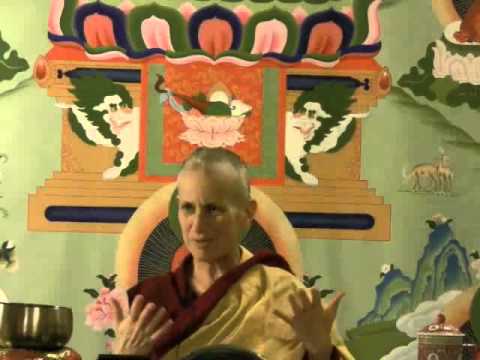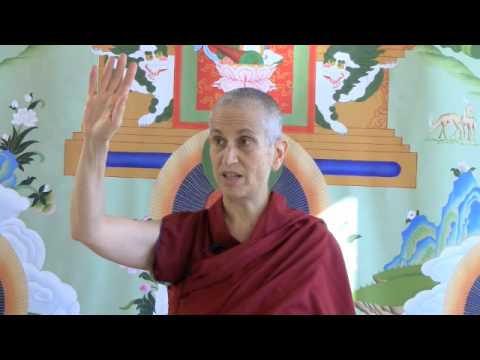Tara is not inherently existent
Part of a series of Bodhisattva's Breakfast Corner talks given during the Green Tara Winter Retreat from December 2009 to March 2010.
- Tara should not be viewed as inherently existent
- Meditating on emptiness during the sadhana
Green Tara Retreat 010: Tara is not inherently existent (download)
Yesterday we were also talking about not anthropomorphizing Tara. Another reason is because when we do that too much, we start to see Tara as an inherently existent person. With any of these buddha figures, we don’t want to see them as inherently existent people because then we’re grasping at true existence. It also gives us quite a strange idea of what a buddha is and then we start thinking, “Oh, but if I pray to Tara then I’m not praying to Manjushri and maybe Manjushri’s going to get upset because he feels neglected.” Our mind does all these very strange kind of things. Whereas, if we see buddhas as manifestations of qualities, then we don’t have the tendency to grasp them as truly existent as much. We realize they all have the same qualities and that the form is an outward appearance.
If we aren’t grasping Tara as truly existent, maybe we can not grasp ourselves as truly existent too. This is why I said to be careful with Tara. Because we grasp ourselves and everybody around us as truly existent, we think Tara is that way also, whereas, in fact, none of us are. We’re all merely labeled in dependence, on accumulations of different parts, different qualities, different aggregates. Remember that and it helps us in seeing that things are empty and also dependent arising.
A person also had a question about if they are meditating in the sadhana, and they have a glimpse of emptiness, do you stop and meditate on emptiness or do you keep going in the sadhana? Normally you would not have a glimpse of emptiness unless you’re specifically meditating on emptiness. Now it could happen that if you’re very familiar with the meditation on emptiness, and in your break time you’re constantly thinking about dependent arising, then it could happen that you have this glimpse when you know you’re thinking about dependent arising, and walking around. But normally, because emptiness is a non-affirming negation, you usually have to be doing the meditation to identify accurately what emptiness is.
In other words, emptiness is not just your mind being empty of thoughts; it’s not just a vacuous feeling. It’s not like the space in the refrigerator when there’s nothing in it. So you might sometimes get these kind of vacuous feelings, or your mind might be sometimes without thought. That’s fine. And if you like to rest there a little bit, that’s okay. But that’s not going to be the emptiness which is the negation of inherent existence. Especially for us beginners, we have to know what inherent existence would look like if it existed, and then prove to ourselves that it doesn’t exist. That’s the route through which we know emptiness.
So emptiness isn’t like some other phenomenon, like a positive phenomenon that’s just out there. It’s not one that pops into our mind like a bird flies by and pops into our visual awareness. It’s not going to be like that. It’s something that we have to really ponder and understand correctly. Then if you’re very familiar with it, there’s a possibility when you’re doing some other activity that maybe some glimpse comes.
The tradition is very specific about really understanding what emptiness means, and that it’s not just a vacuous feeling or the mind not having thoughts. It is nice when our mind isn’t cluttered with a lot of distracting thoughts. That is very nice, isn’t it? If you have that kind of experience and can stay in that, and then begin to see the nature of the mind itself, that’s quite nice. But that’s seeing the conventional nature of the mind, whereas emptiness is the ultimate nature.
Venerable Thubten Chodron
Venerable Chodron emphasizes the practical application of Buddha’s teachings in our daily lives and is especially skilled at explaining them in ways easily understood and practiced by Westerners. She is well known for her warm, humorous, and lucid teachings. She was ordained as a Buddhist nun in 1977 by Kyabje Ling Rinpoche in Dharamsala, India, and in 1986 she received bhikshuni (full) ordination in Taiwan. Read her full bio.


